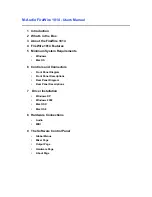
Whilst Teledyne e2v has taken care to ensure the accuracy of the information contained herein it accepts no responsibility for the consequences of any use thereof and
also reserves the right to change the specification of goods without notice. Teledyne e2v accepts no liability beyond that set out in its standard conditions of sale in
respect of infringement of third party patents arising from the use of tubes or other devices in accordance with information contained herein.
Teledyne UK Limited, Waterhouse Lane, Chelmsford, Essex CM1 2QU United Kingdom Teledyne UK Ltd. is a Teledyne Technologies company.
Telephone: +44 (0)1245 493493 Facsimile: +44 (0)1245 492492
Contact Teledyne e2v by e-mail:
or visit
for global sales and operations centres.
© Teledyne UK Limited 2020
A1A-795878 Version 1, May 2020
Template: DF764388A Ver 19
131037
FEATURES
•
Full Frame Spectroscopic Sensor
•
2048 by 264 Pixel Format
•
15µm Square Pixels
•
Active image area 30.72 x 3.96 mm
•
Deep Depleted for higher red response
•
Advanced Inverted Mode Operation (AIMO)
INTRODUCTION
The CCD261-04 is a full frame spectroscopic format
sensor product from Teledyne e2v.
The CCD261-04 has 2048(H) x 264(V) elements.
Each element is 15 µm square. Standard three phase
clocking and buried channel charge transfer are
employed and Advanced Inverted Mode Operation
(AIMO) is included as standard. Teledyne e2v’s AIMO
structure gives a 100 times reduction in dark current
with minimum reduction in full well capacity. Novel
Deep Depletion AIMO technology enhances IR
sensitivity while preserving high spatial resolution and
low dark current.
Designers are advised to consult Teledyne e2v should
they be considering using CCD sensors in abnormal
environments or if they require customised packaging
or performance features.
TYPICAL PERFORMANCE
GENERAL DATA
Format
Package
Pixel readout frequency
1 MHz
Output amplifier sensitivity 6.3 µV/e
-
Peak signal
75 ke
-
/pixel
Spectral range
250–1050 nm
Active Image area
30.72 x 3.96 mm
Active pixels
2048 (H) x 264 (V)
Pixel size
15µm square
Number of output amplifiers 1
Overall dimensions
35.5 x 20.0 mm
Number of pins
20
Inter-pin spacing
2.54 mm
Package type
Ceramic DIL
CCD261-04 Back Illuminated AIMO
Deep Depleted CCD Sensor






























